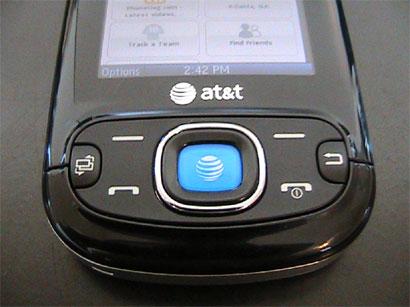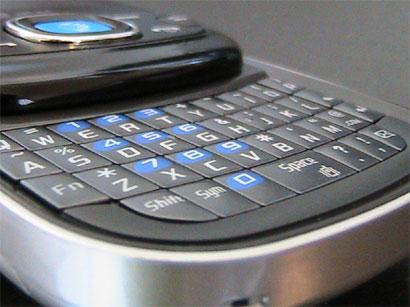Overview
What’s good: Full QWERTY keyboard with rubbery keys make typing and sending messages easy and quick; free trial to XM Satellite Radio; app switching functionality; low price.
What’s bad: No touchscreen; had problems with finding my GPS signal; no headphone jack (3.5 mm or proprietary); 2MP camera has no flash and hardly any photo-editing features.

It’s rare to find a phone with a screen this size (2.6 inches) and it not be a touchscreen device; however, the Strive is packed with other standard features, including a camera, music player, a full QWERTY keyboard, and AT&T navigator. Samsung and AT&T have also added some new features to this messaging phone, including Group Messaging and cloud syncing of your address book. There are a lot of feature phones out there, so what does the Strive do to catch your attention? Does it succeed?
The Samsung Strive is a basic feature/messaging phone and thus ships with minimal accessories. In the box, you’ll find a CD with an interactive tutorial, User Manual (in Spanish and English), USB drivers, and other special promotions. Below that is a Quick Start Guide and other information, the device, battery, and AC adapter. The Strive measures 4.2 inches in length, 2.1 inches in width, and .06 inches in thickness and weighs a mere 4.8 ounces. It’s not as a long as other messaging phones that have side-sliding keyboards, but it’s not so squarish that it looks or feels awkward.

The left side of the device contains only the volume rocker, and the right side is where you’ll find the microUSB charging port and the dedicated camera button. The front of the device is taken up mostly by the display, and it contains two soft keys, a d-pad with a center function button, send and end/power buttons, the back button, and a key that is used to bring up a shortcut menu which also lists your currently running applications. The front panel slides up to reveal the full QWERTY keyboard.

The Samsung Strive features a 2.6-inch screen that supports 262,000 colors and 240x320 pixels. The screen, as mentioned in the outset, is not a touchscreen and tends to get washed out in the sunlight, making it pretty much impossible to see or read anything. The phone is constructed out of plastic, but still feels sturdy as does the sliding mechanism used to access the keyboard. The microSD card slot is located underneath the battery cover.
Navigating through the Strive is simple and easy; press the menu button to access a grid of options including messaging, mobile web, mobile email, music player – the usual. Text messages are organized by conversation and are viewable in a threaded timeline format.

The Strive is definitely a messaging phone. The full QWERTY keyboard worked perfectly for quick and accurate typing. The keys are raised and domed at an angle. They’re not too stiff, but they’re not too squishy either, and the slightly rubbery texture adds traction so you’re fingers don’t slide over the keys when you’re trying to type. The keyboard also contains the numeric pad for dialing. When on the home screen, the keys can simply be pressed to select a number; however, when in messaging mode, you must push the Function button in order to use them.

On the back of the phone is the 2.0-megapixel camera. The camera has no flash but also records video. The phone has a few photo-editing features, including options to change the resolution, change the lighting from daylight to cloudy, etc., set a timer, and a few other picture effects. You can also use the camera for video share. The camera quality was fairly decent – as much as one could expect from a 2.0-megapixel camera.

Call quality on the Strive was fair. Being a basic feature phone, callers were able to hear background noise, but it didn’t inhibit their hearing to the point where they couldn’t understand me. The signal was generally strong in most areas; however, there are going to be problem areas in every city or town.
The Strive ships with a 1000 mAh battery. Estimated talk time is three hours and estimated standby time is about four days. While using the battery heavily – web browsing, messaging, checking e-mail – I was able to get about two days of use before I had to charge it. While not using the phone, the battery lasted the estimated four days.
The Samsung Strive uses AT&T’s 3G GSM network. Browsing speeds were pretty fast. It took only about 30 seconds to fully load the Phonedog homepage. The only network connection problems I had was when Yellowpages or other mapping services were trying to find my location based on my GPS signal. Despite multiple tries, it was never successful.

The Samsung Strive is a basic messaging phone with a great QWERTY keyboard. It lacks a touchscreen, which is probably one reason why the price is so low - $19.99 after rebates with a new contract. Though you may find yourself wishing it was a touchscreen device, the design of keyboard is something not to be taken for granted. You’re fortunate if you can find a device that has a keyboard that is as easy to type on as this one. For that reason, and because not having a touchscreen actually didn’t bother me that much (surprisingly) I would recommend the Strive to anyone who sends a lot of text messages and needs a low price. Pick it up at any AT&T store.